The next day we stopped on the shores of Lake Siverskoye, near the small city of Goritzy, which is home to a beautiful old monastery called the Kirillov–Belozersky Monastery. The monastery was founded in 1397 and in the 16th century, it was the second richest landowner in Russia–the Trinity Monastery near Moscow came first. The murals, which are still visible, date from 1641. The vast walled area of the monastery is nearly ½ mile long and 2 feet thick and was constructed in 1654-80. The monks were readmitted into the higher priory in 1998. The monastery is in the process of being restored and refurbished, so I’m glad we could still see it partly in its old condition. There was a small museum on the grounds that housed many pieces of art work as well as armaments, clothing and religious pieces such as icon covers. Our visit to the monastery at Goritzy was far too short, but the boat was leaving and we had to hurry to get back on board.
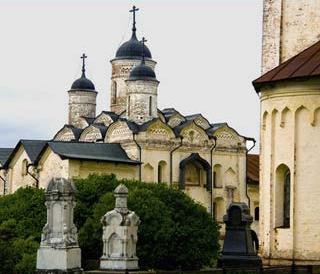
Copyright © Noella Ballenger
One of the several churches in the monastery. Several grave markers are in the foreground.
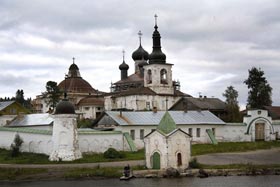
Copyright © Sunny Asch
The Kirillov–Belozersky Monastery has thick walls surrounding it. They served as protection during the earlier years.
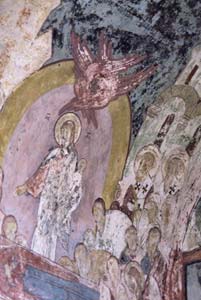
Copyright © Stan & Anne Westfall
Murals on a wall at the
Kirillov–Belozersky Monastery date from 1641.
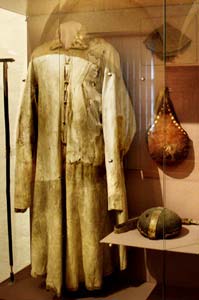
Copyright © Stan & Anne Westfall
In the museum at the Monastery they show the garments worn by the residents.
As we continued down the connecting waterways, we noticed that there were small communities near the shore lines that had small “houses” right along the river banks. These were actually boat storage facilities. The people here use the waterways for transportation, fishing and pleasure. The dams generate electricity and many kinds of goods are moved along from city to city. During the winter months, much, if not all of this activity is stopped due to the weather and the water freezing. All boats are taken from the water and dry docked for the season. But when the rivers open again, they return to being the busy and productive waterways that we saw.
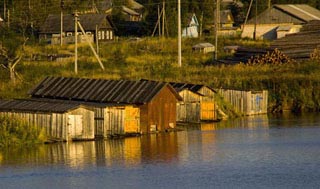
Copyright © Noella Ballenger
Small boat storage houses line the river near the villages. These waterways freeze during the winter months and boats need to be protected.
We stopped in Yaroslavl for some time and had a chance to wander around the city center. This town was founded in the early 11th century and, according to legend, on the very spot where Prince Yaroslav bravely killed a bear. This was a much livelier place and certainly more modern than some of the other towns we had visited. There was a lot of traffic and the people and homes just had a city feel to them. We visited a beautiful church as well as an open air market and a lovely shop where artists sold many of the small lacquered boxes that are famous throughout the world. These boxes are delicately painted with scenes from Russian fairy tales, historic or symbolic designs or places. They are wonderful treasures.
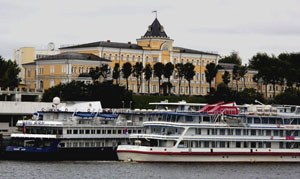
Copyright © Noella Ballenger
Tour boats dock near the a beautiful building in Yaroslavl. Yaroslavl was founded in the early 11th century. Today it is a modern city with theaters and many cultural opportunities.
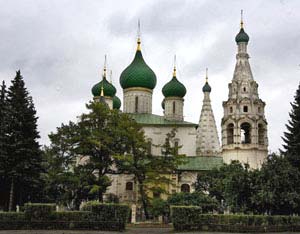
Copyright © Noella Ballenger
The Yaroslavl Church in Ilyinskaya Square–it is noted for its stunningly beautiful icons.
At Uglich, our last river stop before reaching Moscow, we had the chance to really walk through a small portion of the of this delightful city. There were some nice small shops, along with some historic buildings and gardens. And, Uglich is said to be one of the best shopping spots along the river, with its long outdoor section of booths. There were many interesting things for sale and some of the artists were there as well. Nearby was the Bankomat–the Russian ATM machine. My sister and our friend tried to use it, but of course, everything was in Russian. A lovely lady from the nearby hotel came to the rescue, so they did manage to get the machine to cooperate. It was an interesting experience!
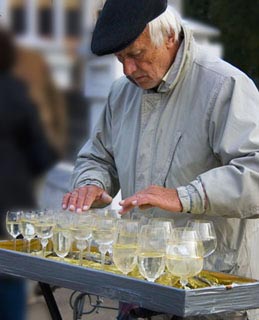
Copyright © Noella Ballenger
We were entertained in Uglich by this man playing music on glasses filled with various levels of water. Each one made a distinct note and the melody was lovely.
In Uglich it was possible to purchase furs, including fur hats in the street markets and open air shops in many places along the way.
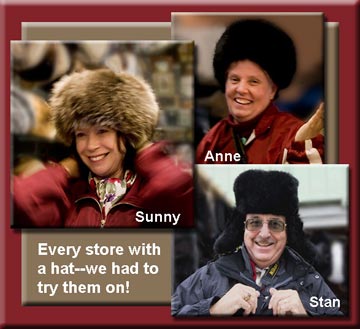
The closer we got to Moscow, the more industrial and the more prosperous the country and the people seemed to become. We passed some beautiful homes and saw quite a few new homes under construction. There were a number of churches that seemed to be actively in the process of restoration. We even passed a building and dock that was said to be a yacht club. It just wasn’t what we expected to see along the Russian waterways.
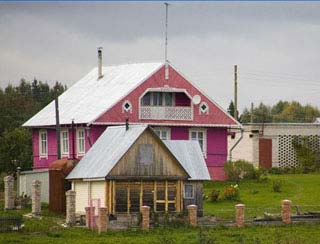
Copyright © Noella Ballenger
Colorful homes and small villages could be seen as we cruised the rivers.
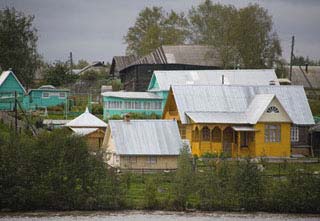
Copyright © Noella Ballenger
It always brightened our day to see a great splash of color along the river banks.
Far sooner than we wanted, we began passing many apartment buildings and other large buildings and were docked in Moscow.
In the next and last segment of this travel article on Russia, I’m going to share some of the interesting places we visited and some of the fascinating sights we saw in Moscow. Also I’ll share with you some of my thoughts and impressions on Russia, along with some additional photo tips.
by Noella Ballenger

Leave a Reply